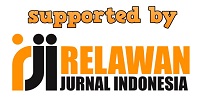MORFOGENESIS ANGGREK (Anoectochilus formosanus) SECARA IN VITRO
Abstract
Anoectochilus formosanus is one species of Orchids, known as a “Jewel Orchids”
and have been used as a folk medicine in China and Taiwan.The aim of this study
was to examine the response of using different types of explants and combination of growth regulators TDZ and BAP to morphogenesis of Anoectochilus formosanus Orchids by in vitro. The results showed that using different types of explants had very significant effect to the percentage of callus and shoot morphogenesis on 12 weeks after planting, the number of adventitious buds, adventitious shoot length, and callus diameter on three weeks until 12 weeks after planting. The best explant to callus morphogenesis was showing on shoot tip explant (50%) and to shoot morphogenesis was showing on auxillary buds and internode explant (100%). The best number of adventitious buds was observed in second internode explant with average number of shoots are 7.62 shoots. The best adventititous length was observed in axillary buds explant with average number of shoot length in 1.16 cm, and the best callus diameter was observed in shoot tip explant with average of diameter in 2.2 mm. The combination of plant growth regulator TDZ and BAP had a very significant effect to adventitious length on 10 weeks after planting, and a significant effect to adventitious length on 11 and 12 weeks after planting. The best adventitious length was observed on 0.25 mg L-1 TDZ + 0.75 mg L-1 BAP in 1.13 cm per explant on 12 weeks after planting. The best combination to callus and shoot morphogenesis was observed on 0.75 mg L-1 TDZ + 0.25 mg L-1 BAP. There was no interaction between used a different types of explant and combination plant growth regulator to morphogenesis Anoectochilus formosanus orchids by in vitro.
Keywords
Full Text:
PDFReferences
DAFTAR PUSTAKA
C.C. Chen., S.J. Chen., A.P. Sagare., and H.S. Tsay. 2000. Adventitious Shoot Regeneration from Stem Internode Explans of
Adenophora triphylla (Thunb.) A. DC. (Campanulaceae)-an
Important Medicinal Herb. Bot. Bull. Acad. Sin. 42: 1-7.
Chang, M.P., M.S. Jeoung., K.Y. Paek., dan J.W. Choi. 2010.
Inhibitory Effect of Jewel Orchid (Anoectochilus formosanus) Planlet Extract against Melanogenesis and Lipid Droplet Accumulation. J. Soc. Cosmet. Scientist Korea. 36 (2): 145-150.
Chiu, N.Y., dan K.H. Chang. 1995. Anoectochilus formosanus
Hayata, in The Illustrated Medical Plants of Taiwan. Vol.
, SMC Publishing Inc., Taipei, Taiwan. 282-283 (in Chinese).
Guo, B., Abbasi, B.H., Zeb, A., Xu LL., Wei, Y.H. 2011. Thidiazuron: a MultiDimensional Plant Growth Regulator. Afr J Biotech 10 (45): 8984-9000.
Hu, S.Y. 1971. The Orchidaceae of China. Quart. J. Taiwan Mus.
: 67-103.
Kan, W.S. 1986. Anoectochilus formosanus Hay. In Pharmaceutical Botany. National Research Institue of
Chinese Medicine, Taipei, Taiwan. 647. (in Chinese).
Ket, N.V., E.J. Hahn., S.Y. Park., D. Chakrabarty., dan K.Y. Paek.
Micropropagation of an Endangered Orchid Anoectochilus formosanus. Biologi Plantarium 48 (3): 339-334.
Khawar, K.M., C. Sancak., S. Uranbey., dan S. Ӧzcan. 2004.
Effect of Thidiazuron on Shoot Regeneration from Different
Explants of Lentil (Lens culinaris Medik.) via Organogenesis. Turk. J. Bot. 28: 421-426.
Kuan, Y.C., Wu, T.J., Kuo, C.Y., Hsu, J.C., Chang W.Y., Sheu, F. 2011. Molecular Cloning of a New Immunomodulatory Protein from Anoectochilus formosanus which Induces B Cell IgM Secretion through a T-Independent Mechanism. PLoS ONE 6 (6): e21004.
Lestari, E.G. 2011. Peranan Zat Pengatur Tumbuh dalam Perbanyakan Tanaman secara Kultur Jaringan. Jurnal Agrobiogen 7 (1): 63-68.
Lu, C.Y. 1993. The Use of Thidiazuron in Tissue Culture. In Vitro Cellular & Develpomental Biology. 29:92- 96.
Maridass, M., M.I. Zahir Hussain., dan G. Raju. 2008. Phytochemical Survey of Orchids in the Tirunelveli Hills
of South India. Ethnobotanical Leaflets 12: 705-12.
Putri, Y. A. 2018. Pengaruh Eksplan Internode dan Komposisi
Media Terhadap Inisiasi Tunas Adventif Anggrek Anoectochilus formosanus secara In Vitro. Skripsi Agroekoteknologi. Fakultas
Pertanian Universitas Sultan Ageng Tirtayasa. Serang.
Rachmawati, F., B. Winarno., N.M.A. Wiendi., N.A. Mattjik., dan A.
Purwito. 2016a. Perbanyakan In Vitro Dendrobium Indonesia
Raya ‘Ina’ melalui Embriogenesis Somatik Berbasis Sistem Bioreaktor. J. Agron. Indonesia 44 (3): 306-314.
Rachmawati, F., Purwito, A.,Wiendi, N.M.A., Mattjik, N.A., dan
Winarno, B. 2016b. Pengembangan Teknologi Perbanyakan Dendrobium Melalui Embriogenesis Somatik Berbasis Bioreaktor.
Disertasi. Program Pascasarjana Institut Pertanian Bogor. Bogor.
Salisbury, B.F., dan C.W. Ross. 1995. Fisiologi Tumbuhan Jilid 3.
Terjemahan: DR. Lukman dan Sumaryono. Bandung: ITB Bandung. 238-255.
Sherif, N.A., T.S. Kumar., dan M.V. Rao. 2017. In vitro Propagation and Genetic Stability Assessment of an Endangered
Terrestrial Jewel Orchid Anoectochilus elantus Lindl. Indian Journal of Experimental Biology. 55: 853-863.
Shiau, Y.J., A.P. Sagare., U.C. Chen., S.R. Yang., dan H.S. Tsay.
Conservation of Anoectochilus formosanus Hayata by Artificial CrossPollination and In Vitro Culture of Seeds. Botanical
Bulletin of Academia Sinica 43: 123-130. Tsay, H.S. 2002. Use of Tissue Culture for the Mass Propagation of Pathogen-Free Plants.
http://www.tc.agnet.org/htmlar ea_file/library/2011080511595
/tb158.pdf. Diakses pada Januari 2019.
Yang, L.C., J.B. Wu, T.J. Lu, dan W.C. Lin. 2012. The Prebiotic
Effect of Anoectochilus formosanus and Its Consequemces on Bone Health. British Journal of Nutrition 109: 1779-1788.
DOI: http://dx.doi.org/10.33512/jur.agroekotek.v11i1.7620
Refbacks
- There are currently no refbacks.
Copyright (c) 2020 Jurnal Agroekoteknologi

This work is licensed under a Creative Commons Attribution-ShareAlike 4.0 International License.
INDEXED BY:
View My Stats

This work is licensed under a Creative Commons Attribution 4.0 International License.










